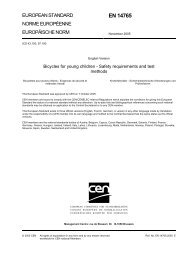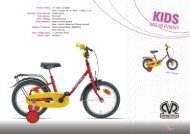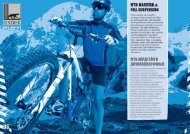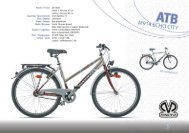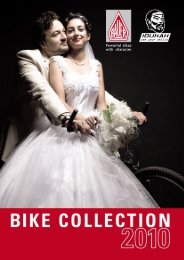EN 14766:2005 - 64_e_stf - Baltik vairas
EN 14766:2005 - 64_e_stf - Baltik vairas
EN 14766:2005 - 64_e_stf - Baltik vairas
- No tags were found...
You also want an ePaper? Increase the reach of your titles
YUMPU automatically turns print PDFs into web optimized ePapers that Google loves.
<strong>EN</strong> <strong>14766</strong>:<strong>2005</strong> (E)After calculating the braking distances, compare the results for the front brake tests with the requirements for bothbrakes in Table 1, and compare the results for the rear brake only with the requirements for the rear brake only inTable 1 to determine whether or not the requirements have been met.VI) LinearityPlot the calculated F Br average values (the arithmetic mean of the three corrected braking forces at each level ofoperating force) against the equivalent operating force values, F Op intend , in order to assess the linearity against therequirement in 4.6.7.5.2.4. Plot the results on a graph, showing the line of best fit and the ± 20 % limit linesobtained by the method of least squares outlined (see Annex A).VII) Ratio between wet and dry brakingFor any operating force (F Op ) for which the measured dry braking-force (F D Br average) is greater than 200 N, the ratiobetween the measured braking-force in wet conditions (F W Br average) and the measured braking-force in dryconditions (F D Br average) shall be greater than 40 %.For each F Op where F D Br average is > 200 N, determine (using the following equation) whether or not the requirementsof have been met:F W Br average : F D Br max average > 4:10For symbols see 4.6.7.5.2.3.VIII) Simple track test (see 4.20)After completion of the machine test, conduct a brief, simple track test with progressively increasing operatingforces to determine whether or not the brakes bring the bicycle to a smooth, safe stop.NOTEThis test can be combined with the test on the fully assembled bicycle.4.6.8 Brakes – heat-resistance test4.6.8.1 GeneralThis test applies to all disc- and hub-brakes but to rim-brakes only where they are known or suspected to bemanufactured from or include thermoplastic materials.Each brake on the bicycle shall be tested individually, but where the front and rear brakes are identical only onebrake need be tested.4.6.8.2 RequirementThroughout the test described in 4.6.8.3, a gap of at least 10 mm shall remain between the hand-brake lever andthe handlebar-grip, the operating force shall not exceed 180 N, and the braking force shall not deviate outside therange 60 N to 115 N.Immediately after having been subjected to the test described in 4.6.8.3, the brakes shall achieve at least 60 % ofthe braking performance which was recorded at the highest operating force used during the performance tests4.6.7.5.2.7 III) a) and b).4.6.8.3 Test methodDrive the wheel and tyre assembly with the brake applied on a machine such as those described in 4.6.7.5.2.4 at avelocity of 12,5 km/h ± 5 % with a rearward, cooling air-velocity of 12,5 km/h ± 10 %, so that a total braking energyof 75 Wh ± 5 % is developed for a period of 15 min ± 2 min.Allow the brake to cool to ambient temperature and then repeat the test cycle.33



